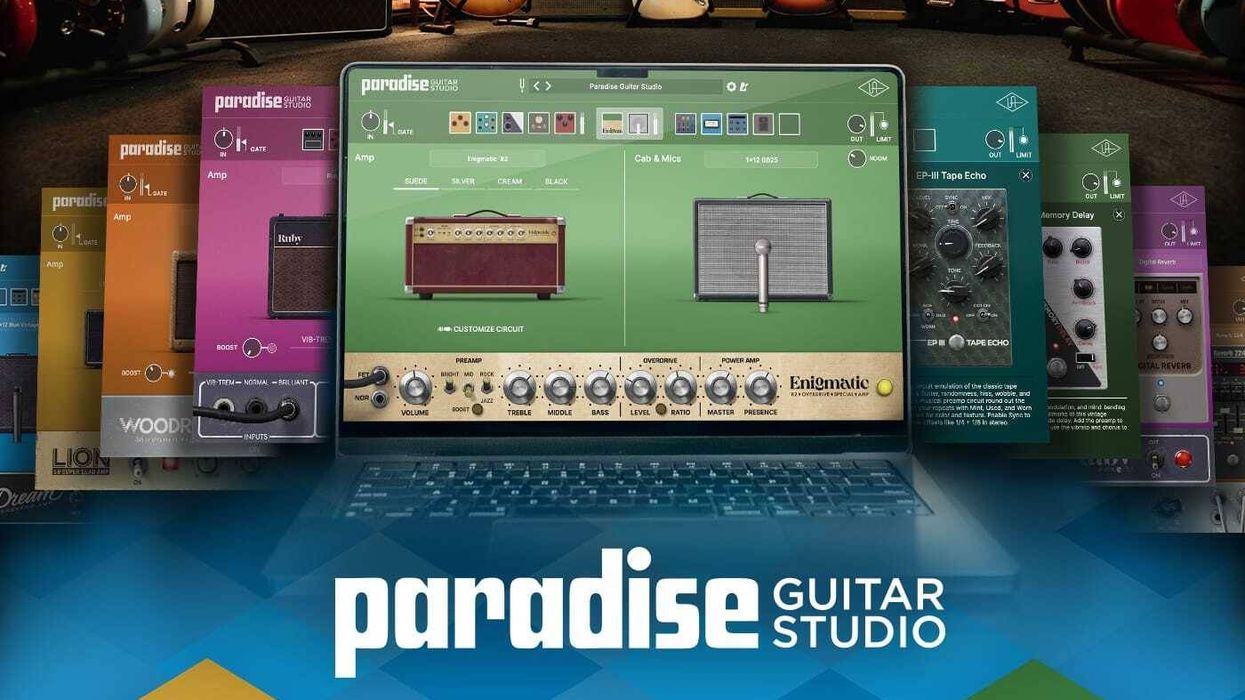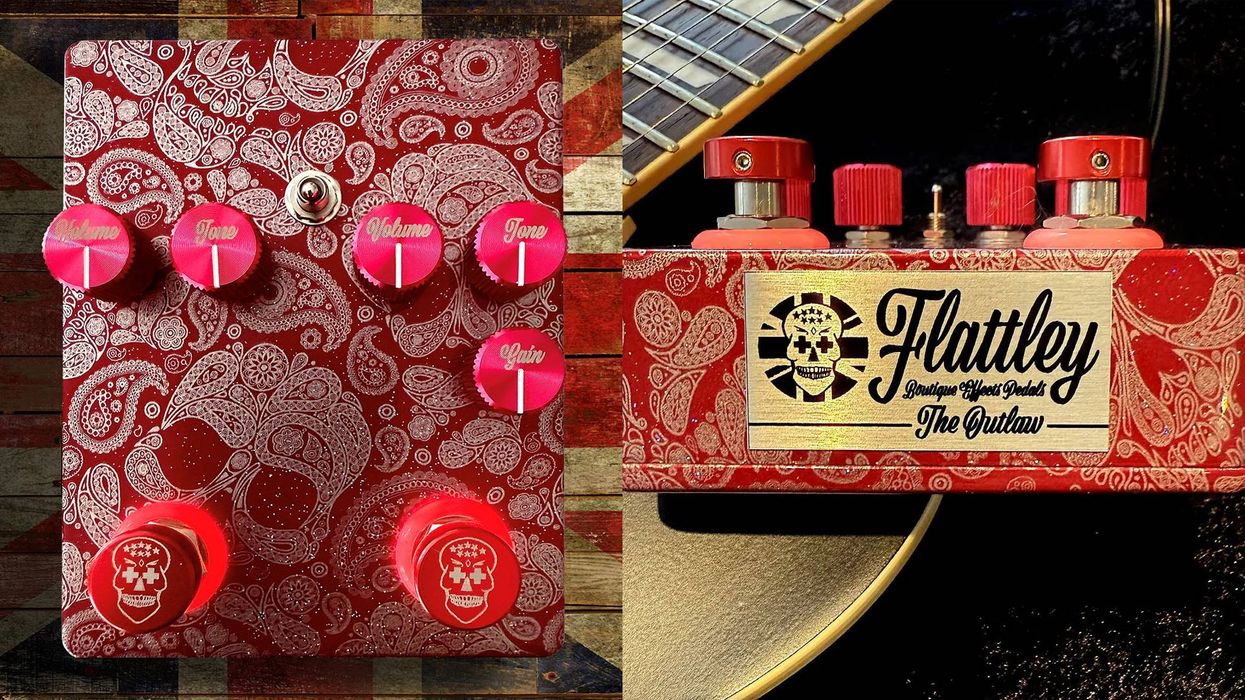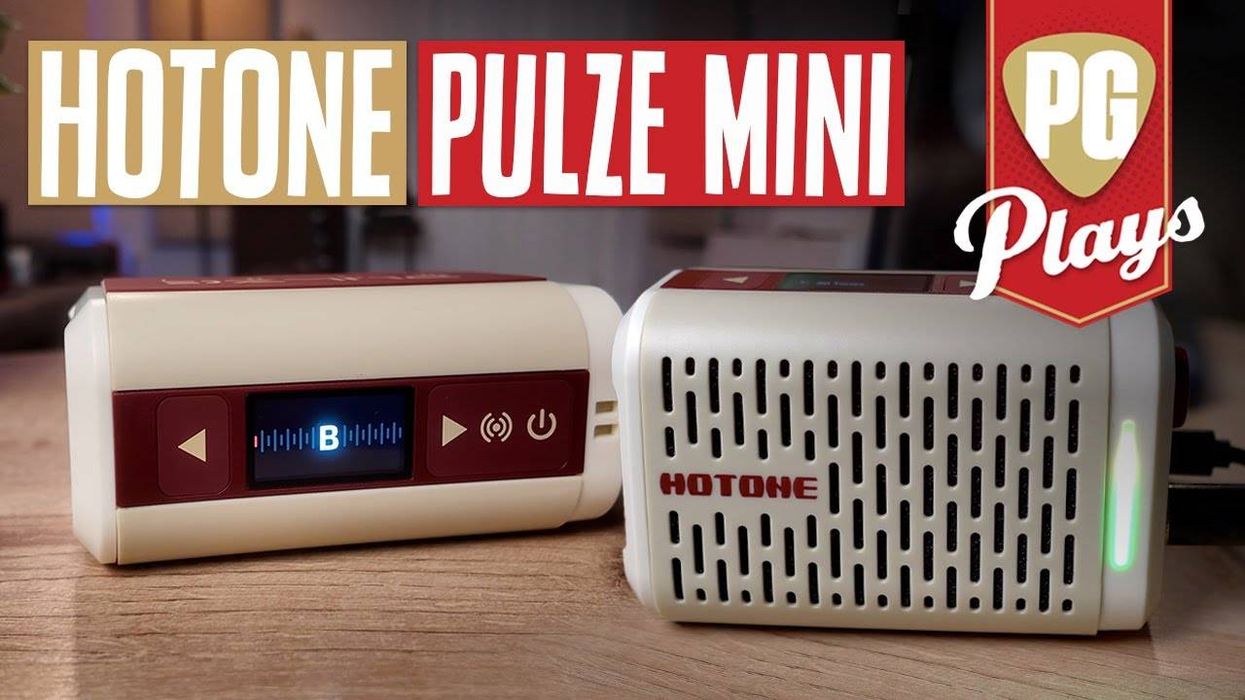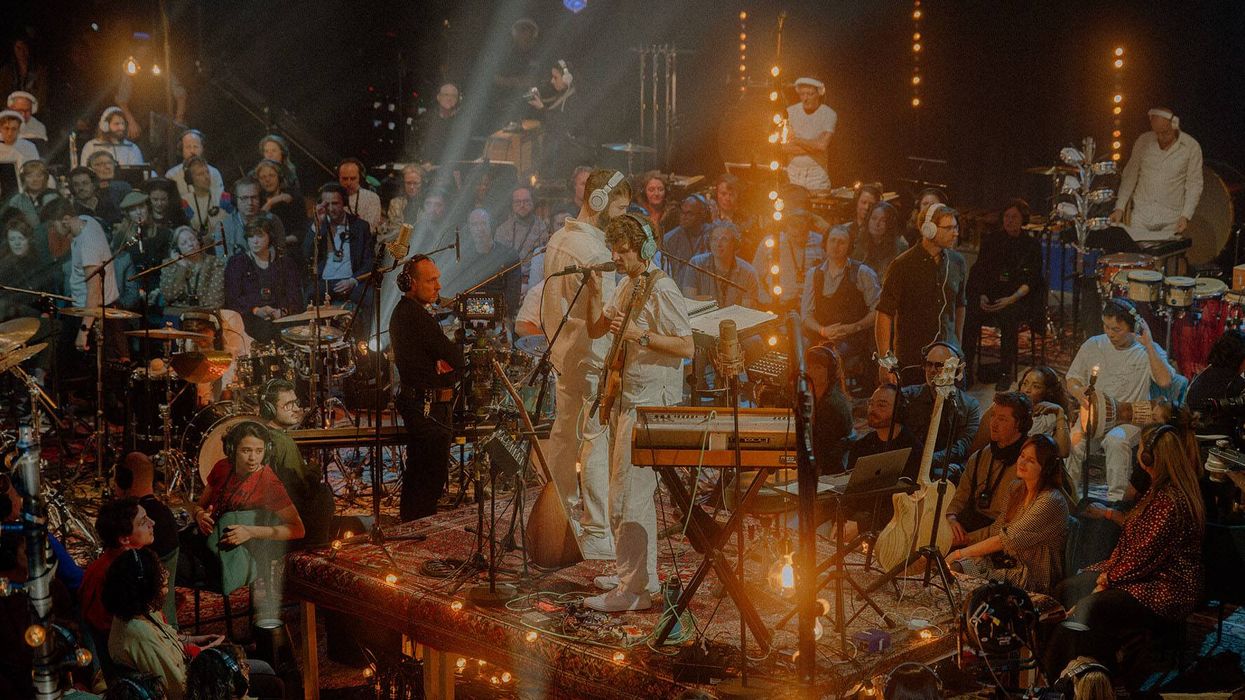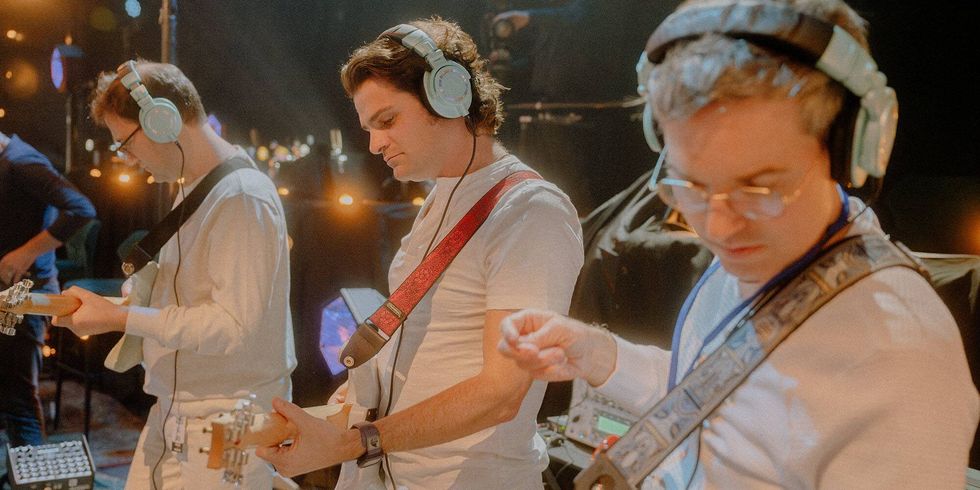Photos by Gabrielle Geiselman
You might think that a guitarist who is so enamored with tone, who spends a large part of his time developing and designing the newest gear, wouldn’t have any time left for touring and records, but we’re talking about Mr. Scary. Ever the creator, Lynch was a founding member of the platinum-selling metal band, Dokken, cultivated the Lynch Mob, produced a string of successful solo projects and, in his latest endeavor, leads a crunch-filled ensemble called Souls of We. Lynch hasn’t had much time to sit and dwell on his past success; rather, he just keeps striving for that “carnal spontaneity” which many of his metal riffs are derived from.
He finds himself just as busy as before, but that’s alright for the six-string virtuoso, who hasn’t shut the door on a Dokken reunion tour later this year and already has some dates lined up with the Lynch Mob. While Lynch can be found anywhere from his George Lynch Dojo Guitar Academy – an internet hub with online lessons from Lynch himself – to playing onstage regularly to hiding away in his personal recording bunker, Lynch Box Studios, he’s always willing to talk gear and tone. We recently tracked him down and got his take on gear, his attitudes on tuning and what it’s like for a decorated rocker to play in front of 60 elementary school kids.
Thanks for talking with us, George. You have a load of stuff going on right now, between Souls of We and the Lynch Mob. What’s been happening lately?
The Souls of We record, Let The Truth Be Known, was just released in August. The band includes myself, London LeGrand from Brides of Destruction, Johnny Chow from Fireball Ministry and Cavalera Conspiracy, and Yael, a female drummer who has played with Dave Grohl and Tom Morello. Featured on the record are a lot of really cool musicians from important musical friendships that have developed over the years. The record was a five-year process, self-produced and done primarily at Henson Studios in Hollywood, and mixed by Mudrock, who mixed Godsmack and Avenged Sevenfold’s first couple records.
Tell me a little bit about Henson Studios.
Well, Henson Studios is very historic. It was Charlie Chaplin’s movie lot in the early 20th century – it’s this huge, private compound. It consists of acres where they have huge sets and old mastering labs. There were all kinds of magnificent producers there, and I learned a lot from just being around them. You’d turn around one day and there’s Ozzy, Paul McCartney, Christina Aguilera or even the Backstreet Boys – like that’s relevant to what I do! And then there were some great jazz musicians and session players like Kenny Aronoff and Abe Laboriel. It was intimidating to a certain extent, but you also realize people are just people.

Sounds like the environment was definitely conducive to just getting your whole creative process rolling. What did you take offsite?
Well, the solos I pretty much did exclusively at Lynch Box Studio, which is just my own private Pro Tools studio, because I felt more comfortable there. If you have PC or Pro Tools rigs, good mics and mic pres, a lot of times you can get what you need from a much smaller, economical room. What you need the big room for is drums and a board to mix and mash. If you’re spending $1500-2200 a day you’re definitely worried about the clock ticking. That’s intimidating and the last thing you want. You also don’t want Paul McCartney or the Backstreet Boys running around outside your studio and popping in when you’re trying to work.
This seems a lot more open than your previous recording situations.
Back in the eighties and early nineties, I was very private and secretive – I wouldn’t even allow the band in. We would go to the extent of nailing plywood up on the doors to keep people out throughout the whole day and night. I would do 20-hour stretches. In fact, there were even points where I would ask the engineer to leave. I would say, “Hey dude, I don’t think it’s necessary that you be here and push that button all day long – I’ll do that.” And he would show me how to run the board and leave – I’d do it myself.
What was your approach to guitar on this recording? Were they tuned to low B?
I used an ESP LTD Viper. It’s alder with an EMG pickup in it – tapped pickups didn’t work very well because the response wasn’t fast enough. They were more dynamic and I missed that, but this is a very un-dynamic guitar – I use it exclusively for doing low-tune rhythms. I’ve actually toured with it and it’s a bitch to play solos on because I’ve got 13s on it. When it’s used for rhythms, it’s phenomenal. It gets a very unique, low-tuning sound, unlike what you generally hear with most new metal bands when they do the low stuff. They’re pretty much interchangeable as far as the guitar sounds with most bands.
It’s hard to get audible mids, which I think can be the biggest challenge with low tunings – actually creating a sound that you can hear that has a mid to it.
That sets you apart. The Viper does that to a certain extent, which is limited by the tuning effect. If you’re in that frequency range, you’re not going to get those mids like you would on a guitar tuned to Eb or E. But on all the overdubs, I used traditionally tuned guitars or alternately tuned guitars. I’d use my Tiger, TL- 56 or Super V, and a lot of times, depending on where the song was recorded, key-wise, I’d use a capo for the rhythm stuff and then do another rhythm on top of it with a capo on a traditionally tuned guitar, just to create another layer that creates an identity and uniqueness to the rhythm sound.

That’s a cool thing, because you talk about layers and that’s kind of an unorthodox approach, the way you’re using different tunings all within that one track that is in low B.
That’s the whole trick – to get things in a spatial composition in the mix and have their own little unique space in that spectrum. That’s why whenever I go for an overdub on the rhythm, even though I’m playing exactly the same thing, I’ll either change the mic pre, the cabinet, amp or guitar, but I’ll leave everything else the same. It gives it a little different character and the trick is to find that blend. Use that other amp to add to it instead of just doing a straight double. Of course, your playing is always slightly different, so that gives it that Iommi doubling effect.
 I was just going to make the Sabbath reference for the touch of out-of-tuneness that makes it cool.
I was just going to make the Sabbath reference for the touch of out-of-tuneness that makes it cool.
He didn’t do it intentionally; he tunes it down to D and uses very light strings because his fingers aren’t real, so he has to use them. That was sort of a happy accident – I don’t think he consciously said, “Ok, I’m going to be out of tune.”
I put all this energy into my gear, writing these songs, getting my engineers and the studio, making everything pristine, getting the mics up and finding the right sound, and I didn’t even have the patience to plug in the tuner. I just thought, “I’ve got an idea, let’s just go with it.”
That’s great – no tuning on the recording, just trust the gear.
Well, it’s great when you do your first track. When I write, I have a very hard time duplicating anything I’ve just played because it’s just off the cuff. Even if I listen to it 50 times, I can never play it exactly the same way or as good as when I played it the first time, so I have to live with that first one. Then, when I overdub it, to tune I have to take that guitar, sample it, run it into the tuner, calibrate the tuner and then tune my next guitar to that calibrated tuner to get the tuning right.
I go for that carnal spontaneity. My ideal record would have the band rehearsing, setting up and recording the fucker. Unfortunately it never happens that way; it’s usually good the first time or the 100th time, but never in-between.
Souls of We has that really cool, strippeddown, natural vibe coming across on the lead tones, and even some vintage tones. How do you get those sounds?
In the studio, I rely mostly on the Lynch Boxes, but I also have an arsenal of other amps, pedals and guitars that I pull from, depending on the moment. First, I do a basic track with the Lynch Box and the Brahma module or the Mr. Scary module, and for the next track I’ll skip over to my ‘69 or ‘68 plexi, or a number of other amps.
 The Brahma module is actually based on your ‘69 plexi, right?
The Brahma module is actually based on your ‘69 plexi, right?
It’s obviously slightly different because we’ve got a different transformer, but I use NOS tubes in them and I’m constantly reworking it. I could just replace all the tubes in my modules to Ei tubes, which makes a tremendous difference over the JJs and other Chinese tubes. I’m constantly evolving those modules.
The other amps that I’ve used for recording this thing have been the ENGL Special Edition head – it has less mids, more of a Boogie-esque sound. For 6L6s, I use a Voodoo and a Budda Superdrive 80. I also use an old, original Soldano SLO100, and I’ve got an old Orange head that I like to use once in a while. I’ve got an old Marshall P.A. head that sometimes I plug in and I occasionally use an old 65 or 130-watt Music Man HD for leads. Both [of the Music Mans] are very unique, with sort of a blackface sound, but they have a transistor front-end that accepts pedals in a really nice way in their power tube section. I use two overdrives when I use that and I use a low input with some delay.
You have quite an array of pedals – I noticed the Cusack Screamer in there...
I’m always swapping out overdrives. I obviously use Tube Screamers and hybrid Tube Screamers – which the Cusack is. I have the Lynch Time Machine Boost – the hand-wired version. It’s got silicon, germanium and FET; it has all three in one so you can pick and choose. I just use a straight overdrive on it most of the time, but sometimes I use the germanium when I want something a little nastier. I’ve got a Keeley-modified DS-1, an early Japanese DS-1, and I really like the TIM pedal as well – it has a great overdrive.
There are so many overdrive pedals out there, so I swap those out because it really depends on the amp. As far as the Lynch Boxes, I find that I don’t even need overdrive with those because they have enough drive where it actually compresses the sound too much and kind of destroys the frequency range to a certain extent. I think if you can get away without overdrive that’s the best thing.
Let’s talk about your guitars that are up in more normal registers. I saw Seth Lovers and all sorts of Duncans in your guitars. Do you just kind of pick the one that’s right for that guitar?
Absolutely, I sort of steer to the Seymour Duncan Screamin’ Demon pickup on heavier-weight guitars. I tend to use lighter guitars these days, in the 8.5 to 9 lb range; I like the way they resonate. I’m also kind of steering away from maple and going to alder. The alder with a maple top, maple neck with a maple cap, you get the brightness and the pop, but you still get the warmth.
We developed a Super V pickup for lighter guitars, which has a kind of a unique design in that each coil is wound differently with different materials and different gauged wire. It’s a very Seth Lover-ish kind of pickup with a little more output. It’s what a lot of people try to do – create something PAF-ish – but with a little more to it. But the Screamin’ Demon is pretty much my default pickup, although I do dabble in other Duncan pickups. I’ll even try some pickups from other manufacturers here and there just to know what’s out there. I usually try to get my hands on a lot of different things and see how they react in my guitars.
I think you really have to find the right pickup for the specific guitar. All pickups sound different depending on the weight of the guitar and the properties of that specific instrument. What I hate about pickups is trying to find that magic combination because it’s not easy. You sit around with a soldering gun all day taking strings off, putting pickups in and by the time you get a new pickup on there you’ve forgotten what the old one sounded like. So what I tend to do is record the guitar with the pickup that I have in it, take the strings off, change the pickup, put the strings back on and record that onto another track. I use all the same conditions and I do that a number of times, then I go back and listen.
Let’s talk about string gauge and things of that nature. You use 13s on the low B stuff and you kind of mix things up a little bit on your standard tuned guitars.
On most of my guitars I go with the lighter gauge as I get to the heavier strings. The low E is usually lighter than what you’d expect and the top is a litter bit heavier than what you’d expect. I like the gauge to be a little more evenly displaced rather than extreme. I don’t like light tops and heavy bottoms.
My signature Dean Markleys have a higher nickel content, a different core diameter, metal composition and they are wound to pitch, which means the machines wind at a slower speed. That tends to keep the intonation intact.
One of your newer signature projects is with ZOOM – how did the development of that go?
I’d been working with ZOOM, giving them my opinions on different pieces of digital gear, and that evolved to a point where they wanted to do my own pedal.
What a lot of guys do for signature stuff is take something that’s already made, twiddle a few knobs, save it as a preset, and there you go. I didn’t want to do that because there’s a limited amount of stuff you can do when you modify a pedal that way – you have to deal within the parameters of the pedal itself. I wanted to go into the studio with all kinds of gear, with an engineer for a matter of about a week and record different .wav files with different sounds.
For instance, we took a real Leslie and recorded that with an old Marshall, with a Les Paul, and created sounds from that. We’d go old cabinet, old speakers, old pedals, Lynch Boxes, old Super Reverbs, weird amps like WEM Dominators and old tweed Fenders with 12-string guitars, different Strats, Teles, Esquires, Les Pauls and ESPs. For one of the lead tones I use an original EP-1, a 1960s Tube Echoplex. Where are you going to find one of those – much less afford one? I used an old MXR Phase 90 Script Logo, which again, is very difficult to find and very expensive – that’s the old Eddie thing from “Eruption” and other solos. Then we burnt all these .wav files to a chip and they created the algorithms from there. These are all sounds designed from the bottom up specifically for this pedal.
It’s pretty cool that you didn’t just slap your name on top of a pedal and call it good.
That would be much more cost effective, but then do you build something that’s historically significant, meaningful and useful? I don’t think so. I was very happy with them when they decided to let me do it in what I thought was the right way. I use it for all kinds of things, from when I’ve got song ideas and I just want a quick plug-in, to inspiring rehearsing or just practicing.
I just did a thing for my kid at the school – they had a show-and-tell and they had about 60 or 70 kids in the elementary school music room. I plugged the ZOOM pedal into the Lynch Box combo and played “Eruption” for them. They were blown away – I had a better response from them than I usually have at my concerts! It was pretty exciting and a lot of fun.
What about cables? What do you use when you’re recording?
For whatever technical reasons it might be better to have a fatter speaker cable, but I find the opposite to be true for sound. It sounds better when you have a little more impedance or resistance for some reason. I use straight, heavier gauge amp cables and I think that makes an audible difference. As far as guitar leads, I’ve been working with Spectraflex.
With the Spectraflex stuff, I finally decided on a cable type that I really liked, which was the multi-conductor, extra heavy shielding and restrain. I’ve actually worked with them and designed a Lynch specific cable, the Mr. Scary cable. I worked with this jewelry designer that I work with, The Rim, and we came up with a unique end for it – basically a reworking of the Bones guitar. It’s a cast piece, so that’s the shroud around the cable end. And it not only looks cool, but it sounds fucking great, real heavy and substantial.
You’ve mentioned your upcoming instrumental record. Can you share some details on it?
Absolutely, it’s a three song EP called Hang ‘Em High. Two of the songs, one called “Kill Whitey” and the other one called “Hang ‘Em High,” are a little more reminiscent of old school rock, a more modernized version of UFO. But it’s also ripping, you know? It’s not new music, it’s more of a throwback and I think a lot of people will really identify with that.
There’s also sort of a much quieter song on there called “Maya,” which is kind of a beautiful song. It’s not a heavy song, but it’s just neat. I plugged it into my Brahma with an old ‘59 Esquire that a friend of mine loaned me. It’s sort of reminiscent of Jeff Beck’s style. The EP is going to be offered exclusively through the Mob Shop at GeorgeLynch.com.
And the Dojo online courses are still rocking and rolling?
Yeah, it’s a model that I think people really like because for a very small amount of money you get as close as you really can to having a sit-down lesson. All these lessons are archived where you can go back and look through hundreds of lessons that we’ve done in the past. Not only are the lessons done a lot of the time in my studio, but we do a lot of gear exploration. We’ll try this pedal, this amp, this guitar and show the pros and cons – a thing that I like to use and experiment with.
We show how we record and the importance of the little things; we also show how I think of a composition and how I create it. So I’ll sit there with my engineer and we’ll start out with a basic drum track that we create ourselves with software examples – which is how I write – and then I come up with a riff and say, “Ok, here’s your basic riff and here’s what that would evolve into. Here’s the prechorus, here’s the chorus. Ok, those are your three main parts, now you have a song, they all fit together nicely, and now we want to overdub that. We want to put a clean on top of it, or we may want to throw a solo on top of it, mix it down.” We get into all areas of the guitar-centric world. It’s not just lessons – it’s beyond that, with plenty of other things guitarists need to know.
So it’s about gear and the application of that gear. One thing I notice is you see the big picture with everything.
Yeah, I’m a complete gear nut. I don’t have the time or the resources to have everything and try everything, but I’m always looking on Craigslist and I’ve got my ear to the road, checking out new stuff. I’m a big fan of that kind of stuff, kind of in the Billy Gibbons way, where I’m always changing shit up, exploring and finding new things.
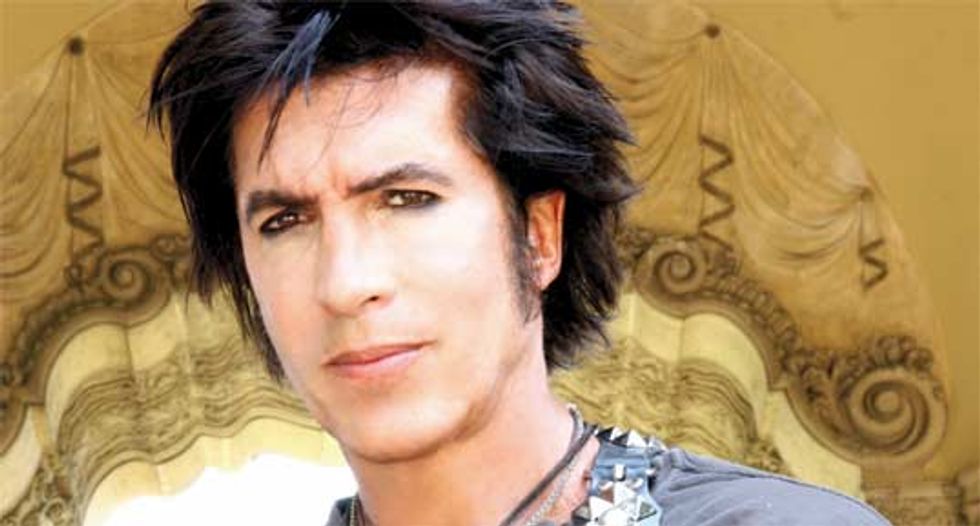 | |
| |
As musicians gain fame and fortune through their musical accomplishments, some fall victim to the condition we often label as “gear lust” or GAS – Gear Acquisition Syndrome. While some go after Golden Era solidbodies or trick their pedalboard out with an assortment of boutique fuzzes, flangers and delays, a select few try to put their stamp on everything that can be plugged or played. The leader of this select group is none other than George Lynch, who is not only a long-time sufferer of GAS, but also a stellar guitarist who has initiated and developed signature Randall Amps, ESP guitars, Dean Markley strings, the Seymour Duncan Screamin’ Demon pickup and countless other effects and accessories. It’s such an affliction that Lynch extensively alters his rigs for each tour, all in search of the perfect setup. Before Lynch, this would have been pure insanity; now it’s de rigueur for any major artist. While Lynch didn’t invent gear lust, he certainly had a hand in legitimizing it. |
You might think that a guitarist who is so enamored with tone, who spends a large part of his time developing and designing the newest gear, wouldn’t have any time left for touring and records, but we’re talking about Mr. Scary. Ever the creator, Lynch was a founding member of the platinum-selling metal band, Dokken, cultivated the Lynch Mob, produced a string of successful solo projects and, in his latest endeavor, leads a crunch-filled ensemble called Souls of We. Lynch hasn’t had much time to sit and dwell on his past success; rather, he just keeps striving for that “carnal spontaneity” which many of his metal riffs are derived from.
He finds himself just as busy as before, but that’s alright for the six-string virtuoso, who hasn’t shut the door on a Dokken reunion tour later this year and already has some dates lined up with the Lynch Mob. While Lynch can be found anywhere from his George Lynch Dojo Guitar Academy – an internet hub with online lessons from Lynch himself – to playing onstage regularly to hiding away in his personal recording bunker, Lynch Box Studios, he’s always willing to talk gear and tone. We recently tracked him down and got his take on gear, his attitudes on tuning and what it’s like for a decorated rocker to play in front of 60 elementary school kids.
Thanks for talking with us, George. You have a load of stuff going on right now, between Souls of We and the Lynch Mob. What’s been happening lately?
The Souls of We record, Let The Truth Be Known, was just released in August. The band includes myself, London LeGrand from Brides of Destruction, Johnny Chow from Fireball Ministry and Cavalera Conspiracy, and Yael, a female drummer who has played with Dave Grohl and Tom Morello. Featured on the record are a lot of really cool musicians from important musical friendships that have developed over the years. The record was a five-year process, self-produced and done primarily at Henson Studios in Hollywood, and mixed by Mudrock, who mixed Godsmack and Avenged Sevenfold’s first couple records.
Tell me a little bit about Henson Studios.
Well, Henson Studios is very historic. It was Charlie Chaplin’s movie lot in the early 20th century – it’s this huge, private compound. It consists of acres where they have huge sets and old mastering labs. There were all kinds of magnificent producers there, and I learned a lot from just being around them. You’d turn around one day and there’s Ozzy, Paul McCartney, Christina Aguilera or even the Backstreet Boys – like that’s relevant to what I do! And then there were some great jazz musicians and session players like Kenny Aronoff and Abe Laboriel. It was intimidating to a certain extent, but you also realize people are just people.
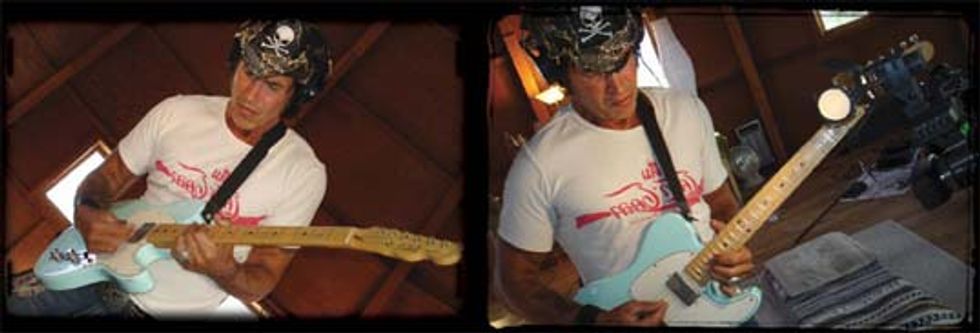
Sounds like the environment was definitely conducive to just getting your whole creative process rolling. What did you take offsite?
Well, the solos I pretty much did exclusively at Lynch Box Studio, which is just my own private Pro Tools studio, because I felt more comfortable there. If you have PC or Pro Tools rigs, good mics and mic pres, a lot of times you can get what you need from a much smaller, economical room. What you need the big room for is drums and a board to mix and mash. If you’re spending $1500-2200 a day you’re definitely worried about the clock ticking. That’s intimidating and the last thing you want. You also don’t want Paul McCartney or the Backstreet Boys running around outside your studio and popping in when you’re trying to work.
This seems a lot more open than your previous recording situations.
Back in the eighties and early nineties, I was very private and secretive – I wouldn’t even allow the band in. We would go to the extent of nailing plywood up on the doors to keep people out throughout the whole day and night. I would do 20-hour stretches. In fact, there were even points where I would ask the engineer to leave. I would say, “Hey dude, I don’t think it’s necessary that you be here and push that button all day long – I’ll do that.” And he would show me how to run the board and leave – I’d do it myself.
What was your approach to guitar on this recording? Were they tuned to low B?
I used an ESP LTD Viper. It’s alder with an EMG pickup in it – tapped pickups didn’t work very well because the response wasn’t fast enough. They were more dynamic and I missed that, but this is a very un-dynamic guitar – I use it exclusively for doing low-tune rhythms. I’ve actually toured with it and it’s a bitch to play solos on because I’ve got 13s on it. When it’s used for rhythms, it’s phenomenal. It gets a very unique, low-tuning sound, unlike what you generally hear with most new metal bands when they do the low stuff. They’re pretty much interchangeable as far as the guitar sounds with most bands.
It’s hard to get audible mids, which I think can be the biggest challenge with low tunings – actually creating a sound that you can hear that has a mid to it.
That sets you apart. The Viper does that to a certain extent, which is limited by the tuning effect. If you’re in that frequency range, you’re not going to get those mids like you would on a guitar tuned to Eb or E. But on all the overdubs, I used traditionally tuned guitars or alternately tuned guitars. I’d use my Tiger, TL- 56 or Super V, and a lot of times, depending on where the song was recorded, key-wise, I’d use a capo for the rhythm stuff and then do another rhythm on top of it with a capo on a traditionally tuned guitar, just to create another layer that creates an identity and uniqueness to the rhythm sound.
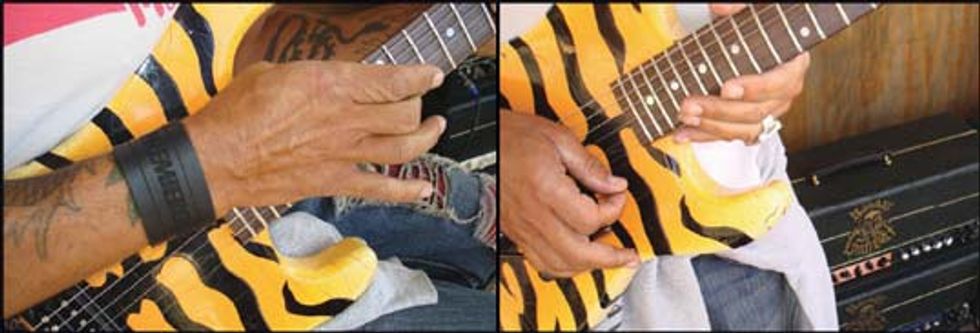
That’s a cool thing, because you talk about layers and that’s kind of an unorthodox approach, the way you’re using different tunings all within that one track that is in low B.
That’s the whole trick – to get things in a spatial composition in the mix and have their own little unique space in that spectrum. That’s why whenever I go for an overdub on the rhythm, even though I’m playing exactly the same thing, I’ll either change the mic pre, the cabinet, amp or guitar, but I’ll leave everything else the same. It gives it a little different character and the trick is to find that blend. Use that other amp to add to it instead of just doing a straight double. Of course, your playing is always slightly different, so that gives it that Iommi doubling effect.
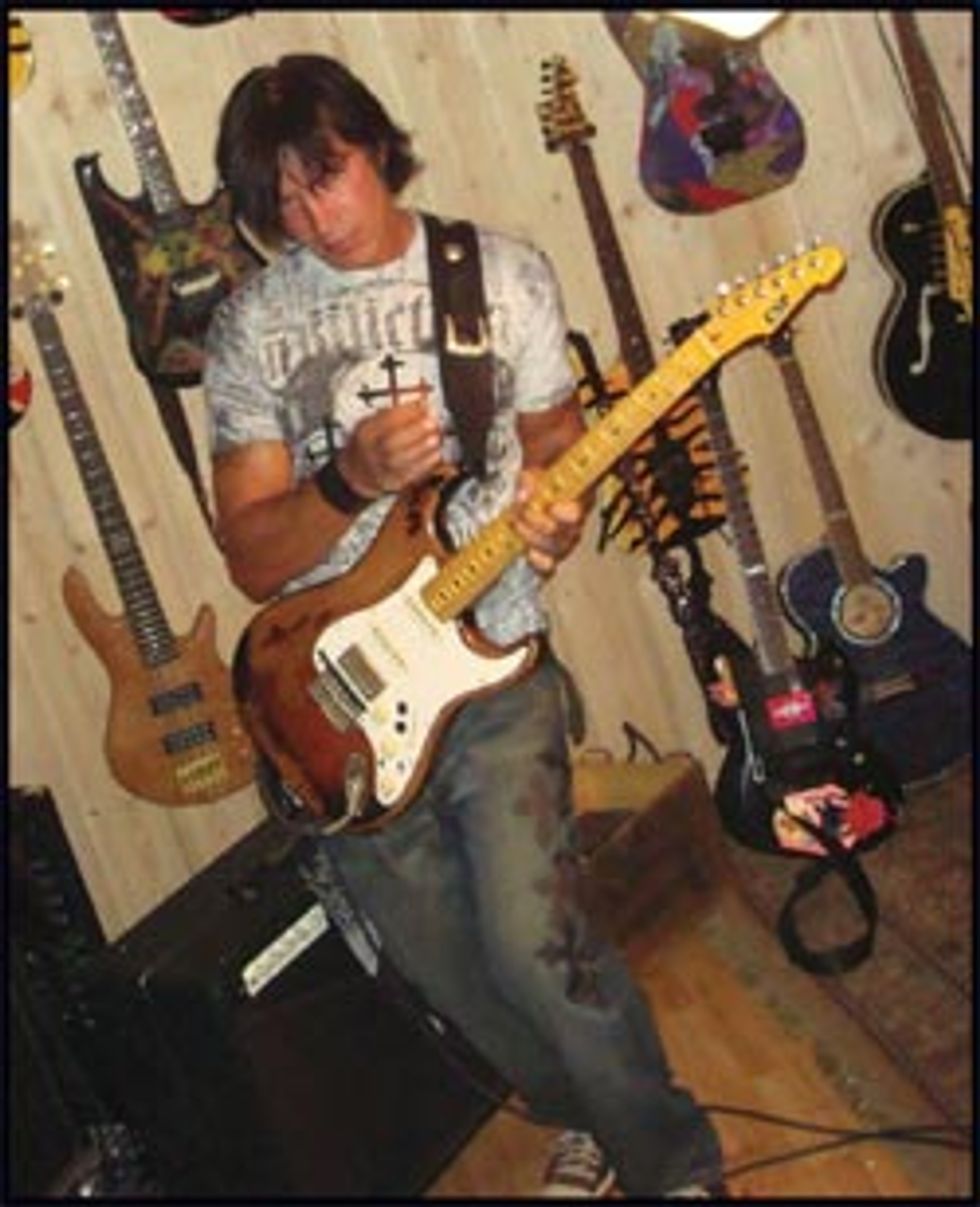 I was just going to make the Sabbath reference for the touch of out-of-tuneness that makes it cool.
I was just going to make the Sabbath reference for the touch of out-of-tuneness that makes it cool. He didn’t do it intentionally; he tunes it down to D and uses very light strings because his fingers aren’t real, so he has to use them. That was sort of a happy accident – I don’t think he consciously said, “Ok, I’m going to be out of tune.”
I put all this energy into my gear, writing these songs, getting my engineers and the studio, making everything pristine, getting the mics up and finding the right sound, and I didn’t even have the patience to plug in the tuner. I just thought, “I’ve got an idea, let’s just go with it.”
That’s great – no tuning on the recording, just trust the gear.
Well, it’s great when you do your first track. When I write, I have a very hard time duplicating anything I’ve just played because it’s just off the cuff. Even if I listen to it 50 times, I can never play it exactly the same way or as good as when I played it the first time, so I have to live with that first one. Then, when I overdub it, to tune I have to take that guitar, sample it, run it into the tuner, calibrate the tuner and then tune my next guitar to that calibrated tuner to get the tuning right.
I go for that carnal spontaneity. My ideal record would have the band rehearsing, setting up and recording the fucker. Unfortunately it never happens that way; it’s usually good the first time or the 100th time, but never in-between.
Souls of We has that really cool, strippeddown, natural vibe coming across on the lead tones, and even some vintage tones. How do you get those sounds?
In the studio, I rely mostly on the Lynch Boxes, but I also have an arsenal of other amps, pedals and guitars that I pull from, depending on the moment. First, I do a basic track with the Lynch Box and the Brahma module or the Mr. Scary module, and for the next track I’ll skip over to my ‘69 or ‘68 plexi, or a number of other amps.
 The Brahma module is actually based on your ‘69 plexi, right?
The Brahma module is actually based on your ‘69 plexi, right? It’s obviously slightly different because we’ve got a different transformer, but I use NOS tubes in them and I’m constantly reworking it. I could just replace all the tubes in my modules to Ei tubes, which makes a tremendous difference over the JJs and other Chinese tubes. I’m constantly evolving those modules.
The other amps that I’ve used for recording this thing have been the ENGL Special Edition head – it has less mids, more of a Boogie-esque sound. For 6L6s, I use a Voodoo and a Budda Superdrive 80. I also use an old, original Soldano SLO100, and I’ve got an old Orange head that I like to use once in a while. I’ve got an old Marshall P.A. head that sometimes I plug in and I occasionally use an old 65 or 130-watt Music Man HD for leads. Both [of the Music Mans] are very unique, with sort of a blackface sound, but they have a transistor front-end that accepts pedals in a really nice way in their power tube section. I use two overdrives when I use that and I use a low input with some delay.
You have quite an array of pedals – I noticed the Cusack Screamer in there...
I’m always swapping out overdrives. I obviously use Tube Screamers and hybrid Tube Screamers – which the Cusack is. I have the Lynch Time Machine Boost – the hand-wired version. It’s got silicon, germanium and FET; it has all three in one so you can pick and choose. I just use a straight overdrive on it most of the time, but sometimes I use the germanium when I want something a little nastier. I’ve got a Keeley-modified DS-1, an early Japanese DS-1, and I really like the TIM pedal as well – it has a great overdrive.
There are so many overdrive pedals out there, so I swap those out because it really depends on the amp. As far as the Lynch Boxes, I find that I don’t even need overdrive with those because they have enough drive where it actually compresses the sound too much and kind of destroys the frequency range to a certain extent. I think if you can get away without overdrive that’s the best thing.
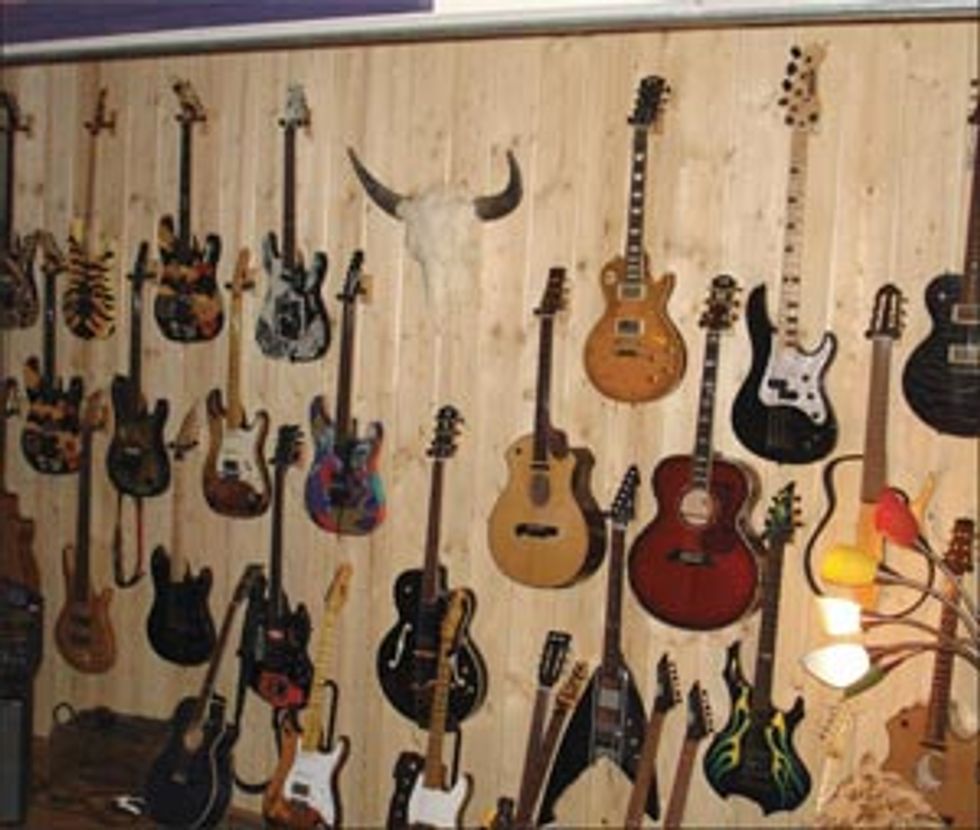 | |
|
Absolutely, I sort of steer to the Seymour Duncan Screamin’ Demon pickup on heavier-weight guitars. I tend to use lighter guitars these days, in the 8.5 to 9 lb range; I like the way they resonate. I’m also kind of steering away from maple and going to alder. The alder with a maple top, maple neck with a maple cap, you get the brightness and the pop, but you still get the warmth.
We developed a Super V pickup for lighter guitars, which has a kind of a unique design in that each coil is wound differently with different materials and different gauged wire. It’s a very Seth Lover-ish kind of pickup with a little more output. It’s what a lot of people try to do – create something PAF-ish – but with a little more to it. But the Screamin’ Demon is pretty much my default pickup, although I do dabble in other Duncan pickups. I’ll even try some pickups from other manufacturers here and there just to know what’s out there. I usually try to get my hands on a lot of different things and see how they react in my guitars.
I think you really have to find the right pickup for the specific guitar. All pickups sound different depending on the weight of the guitar and the properties of that specific instrument. What I hate about pickups is trying to find that magic combination because it’s not easy. You sit around with a soldering gun all day taking strings off, putting pickups in and by the time you get a new pickup on there you’ve forgotten what the old one sounded like. So what I tend to do is record the guitar with the pickup that I have in it, take the strings off, change the pickup, put the strings back on and record that onto another track. I use all the same conditions and I do that a number of times, then I go back and listen.
Notes from a Super Fan George Lynch is a living god. He is the man! He is the living embodiment of badassedness on guitar. With his trademark splayed fingers of his right hand and a slippery left, Lynch had his own inimitable style while everyone else was cloning Eddie Van Halen. There is only one George Lynch and, like all great iconic guitarists, you can always tell it’s him after hearing just a few licks. I’ve been a George Lynch fan ever since “Paris Is Burning” came out, and I’ve seen him live a bunch of times – both back in the eighties and recently. Years ago, I saw him with Dokken in Chicago opening for Aerosmith. I had no interest in Aerosmith; I was on a mission to see the man with the cool ESP guitars, the wicked paint job and the big eighties hair. I was in the front row and he literally messed up my mind. He had heinous licks and spine-tingling vibrato. My friend Mickey and I looked at each other with our Jheri curls, jaws on the floor, and said, “Damn!” Then there was the notorious Dio-Dokken tour – George Lynch versus Vivian Campbell. It was ferocious – don’t get me started. A completely different experience was at The Key Club in Hollywood, when two rappers got up on stage with the Lynch Mob. Nobody knew what to expect, and the audience was a little apprehensive until Lynch started playing these gargantuan riffs. It was awesome! Even now, he still brings the rawk. He’s buff, too – if they ever do a sequel to the movie 300 and they need a guitar player, the casting director should consider George Lynch. One of my favorite things to do is go to a guitar store, plug into a nice rig and play the main riff to “Mr. Scary.” Even if kids don’t know what I’m playing, they can’t help but approach me and say, “Dude, that’s a cool riff!” I tell them, “This riff was created by George Lynch and he is a living god!” - Oscar Jordan |
On most of my guitars I go with the lighter gauge as I get to the heavier strings. The low E is usually lighter than what you’d expect and the top is a litter bit heavier than what you’d expect. I like the gauge to be a little more evenly displaced rather than extreme. I don’t like light tops and heavy bottoms.
My signature Dean Markleys have a higher nickel content, a different core diameter, metal composition and they are wound to pitch, which means the machines wind at a slower speed. That tends to keep the intonation intact.
One of your newer signature projects is with ZOOM – how did the development of that go?
I’d been working with ZOOM, giving them my opinions on different pieces of digital gear, and that evolved to a point where they wanted to do my own pedal.
What a lot of guys do for signature stuff is take something that’s already made, twiddle a few knobs, save it as a preset, and there you go. I didn’t want to do that because there’s a limited amount of stuff you can do when you modify a pedal that way – you have to deal within the parameters of the pedal itself. I wanted to go into the studio with all kinds of gear, with an engineer for a matter of about a week and record different .wav files with different sounds.
For instance, we took a real Leslie and recorded that with an old Marshall, with a Les Paul, and created sounds from that. We’d go old cabinet, old speakers, old pedals, Lynch Boxes, old Super Reverbs, weird amps like WEM Dominators and old tweed Fenders with 12-string guitars, different Strats, Teles, Esquires, Les Pauls and ESPs. For one of the lead tones I use an original EP-1, a 1960s Tube Echoplex. Where are you going to find one of those – much less afford one? I used an old MXR Phase 90 Script Logo, which again, is very difficult to find and very expensive – that’s the old Eddie thing from “Eruption” and other solos. Then we burnt all these .wav files to a chip and they created the algorithms from there. These are all sounds designed from the bottom up specifically for this pedal.
It’s pretty cool that you didn’t just slap your name on top of a pedal and call it good.
That would be much more cost effective, but then do you build something that’s historically significant, meaningful and useful? I don’t think so. I was very happy with them when they decided to let me do it in what I thought was the right way. I use it for all kinds of things, from when I’ve got song ideas and I just want a quick plug-in, to inspiring rehearsing or just practicing.
I just did a thing for my kid at the school – they had a show-and-tell and they had about 60 or 70 kids in the elementary school music room. I plugged the ZOOM pedal into the Lynch Box combo and played “Eruption” for them. They were blown away – I had a better response from them than I usually have at my concerts! It was pretty exciting and a lot of fun.
What about cables? What do you use when you’re recording?
For whatever technical reasons it might be better to have a fatter speaker cable, but I find the opposite to be true for sound. It sounds better when you have a little more impedance or resistance for some reason. I use straight, heavier gauge amp cables and I think that makes an audible difference. As far as guitar leads, I’ve been working with Spectraflex.
With the Spectraflex stuff, I finally decided on a cable type that I really liked, which was the multi-conductor, extra heavy shielding and restrain. I’ve actually worked with them and designed a Lynch specific cable, the Mr. Scary cable. I worked with this jewelry designer that I work with, The Rim, and we came up with a unique end for it – basically a reworking of the Bones guitar. It’s a cast piece, so that’s the shroud around the cable end. And it not only looks cool, but it sounds fucking great, real heavy and substantial.
Confessions of a Metal Head I have a confession to make. In my hearts of hearts, I am a metal head. There. I’ve said it. It’s not as if I have tried to hide that fact, it’s just something that is usually not discussed in polite company. Few things will cause a conversation to come to a grinding halt than if you are at a dinner party and the word “Motörhead” escapes your lips. It’s akin to confessing that you play “Dungeons and Dragons”; it may still done, just never talked about. Back in the halcyon days of big hair acts, Dokken had one thing that separated them from any number of Hollywood Boulevard wannabes: George Lynch. He elevated an otherwise forgettable band. George could play with dizzying speed, but he also could call upon equal parts finesse and drama. He had a monster tone and licks to spare. Plus, he just made everything look so damn cool. George hunkered over his custom-made ESP guitars like a praying mantis ready to bite its helpless prey’s head off. George didn’t play his guitar so much as he seemed to be ripping the notes out of a living being, an illusion that was made even more (sur)real during the middle of the “Dream Warriors” video when his guitar came to life. But “Mr. Scary” quickly became Lynch’s signature piece – arguably his answer to Eddie’s “Eruption.” I saw Dokken as an opening act for Aerosmith at the Cow Palace and, while Don Dokken was just painful to watch, George Lynch was simply mesmerizing. By the time when Aerosmith hit the stage, Brad Whitford and Joe Perry seemed hopelessly out of touch. - Adam Hunt |
Absolutely, it’s a three song EP called Hang ‘Em High. Two of the songs, one called “Kill Whitey” and the other one called “Hang ‘Em High,” are a little more reminiscent of old school rock, a more modernized version of UFO. But it’s also ripping, you know? It’s not new music, it’s more of a throwback and I think a lot of people will really identify with that.
There’s also sort of a much quieter song on there called “Maya,” which is kind of a beautiful song. It’s not a heavy song, but it’s just neat. I plugged it into my Brahma with an old ‘59 Esquire that a friend of mine loaned me. It’s sort of reminiscent of Jeff Beck’s style. The EP is going to be offered exclusively through the Mob Shop at GeorgeLynch.com.
And the Dojo online courses are still rocking and rolling?
Yeah, it’s a model that I think people really like because for a very small amount of money you get as close as you really can to having a sit-down lesson. All these lessons are archived where you can go back and look through hundreds of lessons that we’ve done in the past. Not only are the lessons done a lot of the time in my studio, but we do a lot of gear exploration. We’ll try this pedal, this amp, this guitar and show the pros and cons – a thing that I like to use and experiment with.
We show how we record and the importance of the little things; we also show how I think of a composition and how I create it. So I’ll sit there with my engineer and we’ll start out with a basic drum track that we create ourselves with software examples – which is how I write – and then I come up with a riff and say, “Ok, here’s your basic riff and here’s what that would evolve into. Here’s the prechorus, here’s the chorus. Ok, those are your three main parts, now you have a song, they all fit together nicely, and now we want to overdub that. We want to put a clean on top of it, or we may want to throw a solo on top of it, mix it down.” We get into all areas of the guitar-centric world. It’s not just lessons – it’s beyond that, with plenty of other things guitarists need to know.
So it’s about gear and the application of that gear. One thing I notice is you see the big picture with everything.
Yeah, I’m a complete gear nut. I don’t have the time or the resources to have everything and try everything, but I’m always looking on Craigslist and I’ve got my ear to the road, checking out new stuff. I’m a big fan of that kind of stuff, kind of in the Billy Gibbons way, where I’m always changing shit up, exploring and finding new things.
GEORGE’S GEAR BOX
Randall Lynch Box with Brahma, Mr.Scary and Grail modules 1968 Marshall Plexi 100-watt Super Lead unbelievably stock, un-modded SLO-100 “Scientist” (clone, modeled after the very first SLO amp by Mike Soldano) Speaker Cabinets: Randall Lynch Box 4x12 loaded with four Eminence Lynch Super V12 150 watt 8-ohm speakers Early-seventies, basket weave-era Marshall 1960 A 4x12 (slant) cabinet loaded with two Celestion 20-watt pre-Rola speakers and two Celestion 25-watt G12M Heritage speakers at 16-ohms 1965 Hiwatt SE-4123 4x12 loaded with four 50-watt Simms-Watts/Fane speakers at 15 ohms Guitars: ESP Original M-1 Tiger with a single Seymour Duncan Super V prototype pickup and Floyd Rose tremolo ESP GL56 (distressed Strat-type body) with Seymour Duncan Alnico II Pro in the bridge position and Roland GK-3 midi pickup Fender 1959 Esquire with single Tele pickup petrified into the wood of the body. Cables: Spectraflex 1/4” Lynch signature series instrument cables with custom-made circuit breaker plugs Zaolla gold-tipped, frequency shielded 1/4” instrument and 16-gauge speaker cables Strings: Dean Markley Lynch Signature Series Super V strings gauged for Regular top and Light bottom (.010, .013, 0.17, .024, .032, .042) Effects: Zoom G2G George Lynch Signature multiple effects pedal Morley Lynch Dragon 2 Wah pedal (prototype) Cusack Screamer V2 with three position diode selector (set to LED diode clipping) MXR Phase 90 (original, hand-wired vintage from 1974) Boss CE-3 Chorus Ensemble Vintage Mutron Octavider T-Rex Replica delay Original Fulltone DejaVibe (first edition handmade by Mike Fuller in 1994) Morley Lynch Tripler 3–channel signal splitter Late-seventies vintage Boss GE-10 10-band equalizer |



